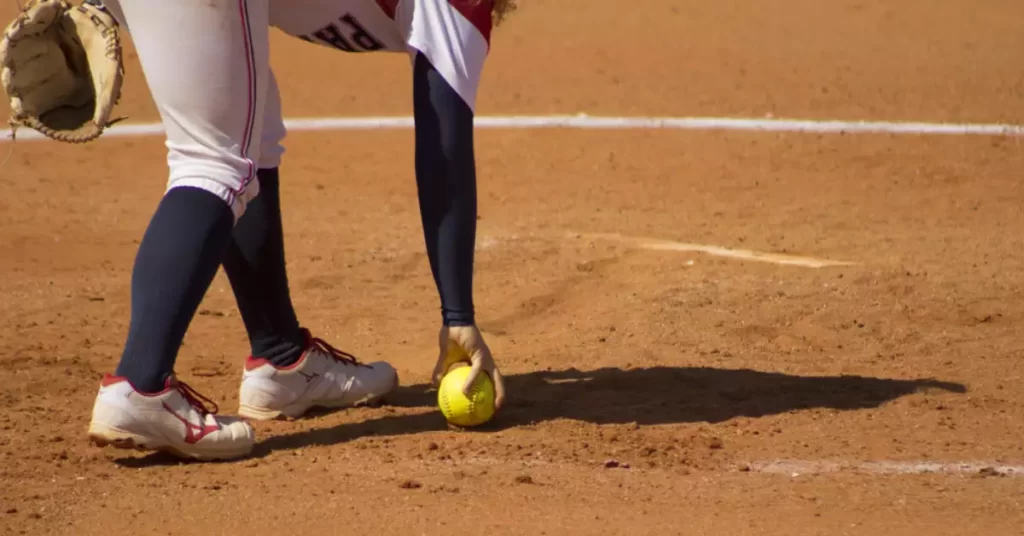The art of pitching in softball offers numerous techniques and strategies. One such technique, the curveball, is a highly effective pitch when executed correctly. Its deceptive movement can leave batters scratching their heads.
The curveball is thrown with a specific grip and wrist motion, resulting in a spin that causes the ball to break away from the batter. When executed correctly, it can become a pitcher’s secret weapon, keeping opponents guessing and off balance.
Ready to elevate your game and become a more formidable pitcher? Let’s dive into the intricacies of the curveball and discover how you can make it an integral part of your softball repertoire.
Understanding the Curveball
A curveball in softball is a pitch that breaks sharply as it approaches the batter, moving horizontally across the plate. This pitch’s deceptive motion is achieved through a combination of grip, release, and body mechanics.
Understanding how these elements work together will help you learn to throw a curveball effectively.
The Importance of Grip
The Basic Curveball Grip
To begin, you’ll need to learn the correct grip for a curveball. Hold the ball with your index and middle fingers spread apart, resting on the top of the seams.
Your thumb should be on the bottom seam, creating a “C” shape with your hand. This grip is essential for generating the proper spin on the ball.
Fingertip Pressure
Applying pressure with your fingertips is crucial for generating the spin necessary for a curveball. As you release the ball, focus on applying pressure to the inside part of the ball with your index finger. This pressure will help create the tight spin that makes the ball curve.

Mastering the Release
The Snap
The release is where the magic happens. As you release the ball, you’ll want to create a snapping motion with your wrist, turning your hand inward. This snap is what generates the tight spin on the ball, causing it to curve.
Follow Through
After the snap, make sure to follow through with your pitching motion. Your arm should finish in a relaxed position, down by your side. A proper follow-through ensures that you are generating enough force to send the ball towards the plate with the desired curve.
Perfecting Your Body Mechanics
Leg Drive
Your legs play a significant role in generating power for your pitch. As you begin your pitching motion, push off the rubber with your back foot, transferring your weight to your front foot. This leg drive will help generate the force necessary for a powerful curveball.
Hip Rotation
As you release the ball, rotate your hips towards the plate. This rotation helps create the necessary torque for a sharp break on the curveball. Make sure to keep your hips closed until you’re ready to release the pitch, and then rapidly rotate them as you snap your wrist.
Shoulder Alignment
Aligning your shoulders is essential for maintaining control and accuracy in your curveball. Keep your shoulders level throughout the pitching motion, ensuring that they stay parallel to the ground.
This will help you maintain a consistent release point and prevent the ball from sailing too high or dropping too low.
Maintaining Consistency in Your Delivery
Consistency is key when it comes to throwing an effective curveball. You’ll want to develop a repeatable pitching motion that allows you to throw the curveball consistently, without tipping off the batter.
Focus on practicing your grip, release, and body mechanics until they become second nature. This will make it easier to throw a curveball with confidence in high-pressure situations.

Tips for Effective Curveball Pitching
Practice, Practice, Practice
The best way to perfect your curveball is to practice consistently. Dedicate time during each practice session to work on your curveball, focusing on the grip, release, and body mechanics. The more you practice, the more natural the pitch will become.
Visualize Success
Visualization can be a powerful tool when learning a new pitch. Imagine the perfect curveball in your mind’s eye, visualizing the ball’s flight path and the break as it approaches the plate. Use this mental imagery to help guide your physical movements as you throw the pitch.
Mix It Up
To keep batters guessing, make sure to mix your curveball in with your other pitches. By varying your pitch selection, you’ll make it more difficult for the batter to anticipate what’s coming next, increasing the effectiveness of your curveball.
Common Curveball Mistakes to Avoid
Over-Rotating
Avoid over-rotating your hand and wrist when releasing the curveball. Over-rotation can lead to a less effective break and make the pitch easier for the batter to hit. Focus on a controlled, smooth snap of the wrist to generate the proper spin.
Tipping Your Pitch
Be mindful of any movements or changes in your delivery that could tip off the batter that a curveball is coming. Keep your delivery consistent across all your pitches to maintain the element of surprise.
Relying Too Heavily on the Curveball
While the curveball can be an effective pitch, don’t rely on it exclusively. Mixing in other pitches, such as fastballs and changeups, will keep batters off-balance and guessing.
Incorporating the Curveball into Your Pitching Arsenal
As you become more confident in your ability to throw a curveball, start incorporating it into your pitching arsenal during games. Use the curveball strategically, mixing it in with other pitches to keep batters guessing and off-balance.
Additional Softball Pitching Resources
For further information on improving your pitching skills, consider exploring online resources, attending pitching clinics, or working with a private pitching coach. These resources can provide valuable insights and tips for perfecting your curveball and overall pitching technique.
- Online resources: Websites, blogs, and YouTube channels dedicated to softball pitching can offer helpful tips and tutorials for improving your curveball.
- Pitching clinics: Many organizations host pitching clinics where experienced coaches teach the fundamentals of various pitches, including the curveball.
- Private coaching: Working one-on-one with a pitching coach can provide personalized guidance and feedback to help you refine your curveball and overall pitching skills.
10. FAQs
How do I get more break on my curveball?
To increase the break on your curveball, focus on perfecting your grip, release, and body mechanics. A tighter grip, stronger wrist snap, and proper hip rotation can all contribute to a sharper break.
Can I throw a curveball without hurting my arm?
Yes, you can throw a curveball without causing harm to your arm if you use proper pitching mechanics and avoid overuse. Make sure to warm up properly and maintain a consistent pitching motion to reduce the risk of injury.
How do I keep the batter from knowing I’m throwing a curveball?
To avoid tipping off the batter, maintain a consistent delivery across all of your pitches. Focus on keeping your grip, body mechanics, and release consistent to make it more difficult for the batter to predict what pitch is coming.
Final Verdict
Embracing the curveball in your softball pitching toolkit can be a game-changer. It adds variety to your style and keeps batters on their toes, unsure of what to expect next. As you practice and refine your technique, you’ll see the benefits of this pitch in action.
Take the time to perfect your grip, body positioning, and release to ensure your curveball’s effectiveness.
With patience and dedication, you’ll soon have opposing teams scrambling to adjust their tactics against your newfound pitching prowess. Now, step onto the mound and unleash the power of the curveball.

